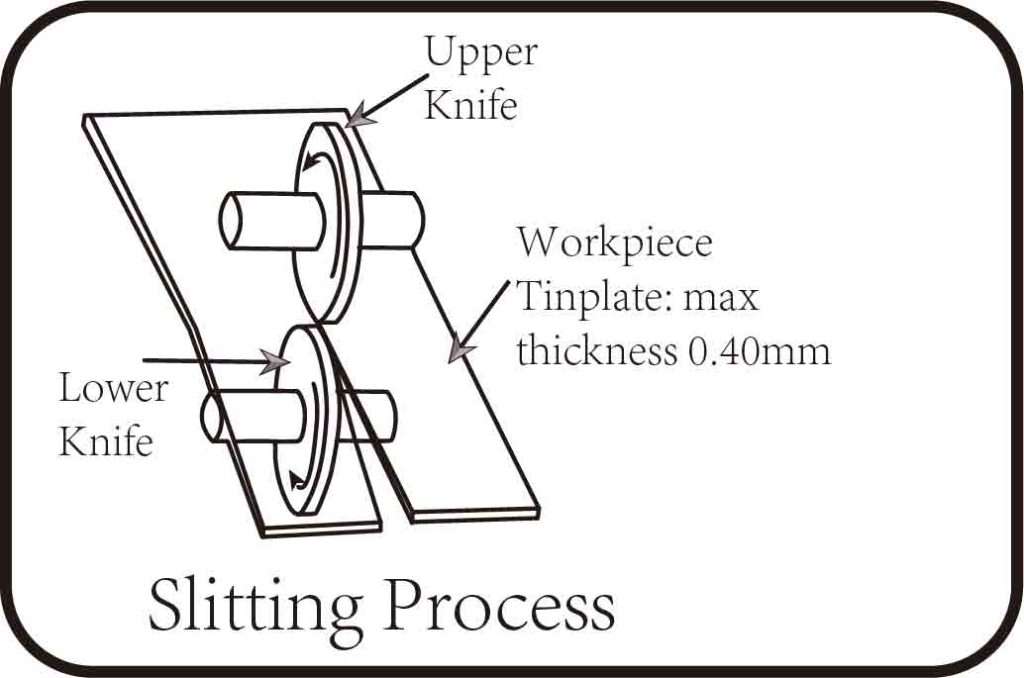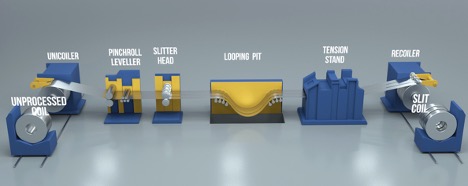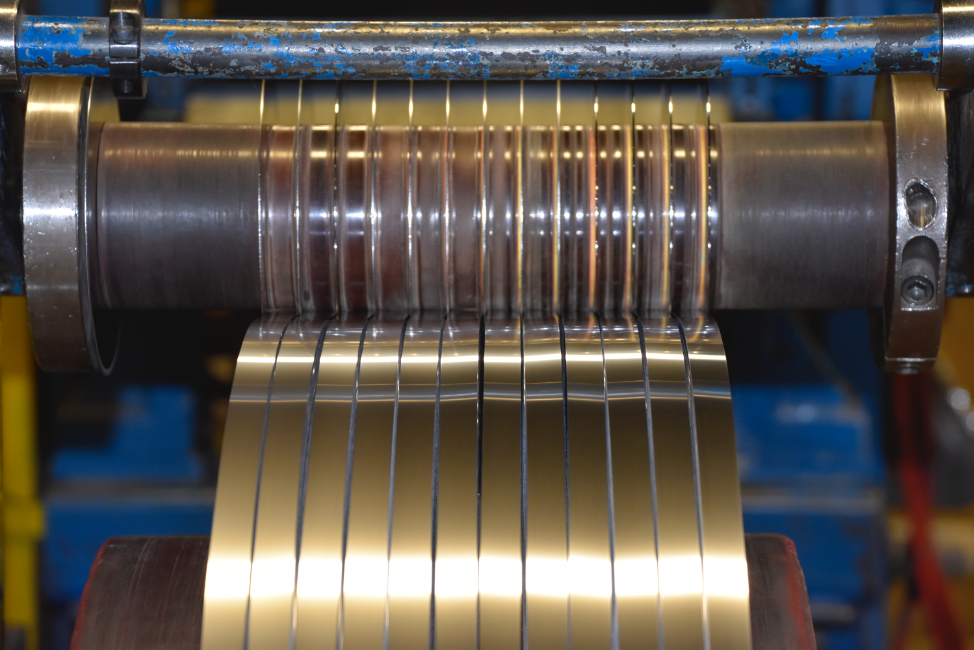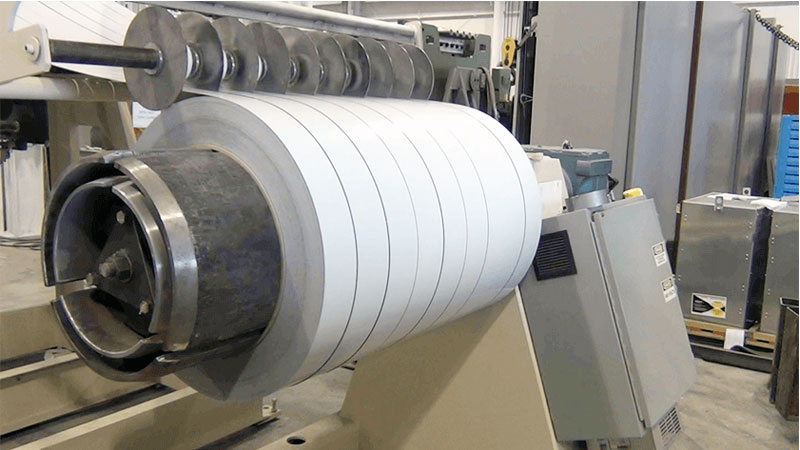
In the manufacturing industry, particularly when dealing with sheet metal, precise cuts matter. One technique employed to achieve this is slitting. This process is a crucial aspect of sheet metal manufacturing, allowing for the efficient sizing and shaping of metal for various applications. From creating HVAC components to automotive parts, the role of slitting operations in sheet metal manufacturing is significant and deserves a comprehensive exploration.
Understanding the Slitting Operations

Slitting operations play a crucial role in many industries, particularly sheet metal manufacturing. But what does it entail, and how is it performed?
Slitting, in the context of sheet metal manufacturing, is a shearing operation that cuts a large roll of material into narrower rolls. The process involves unwinding a large coil of metal and running it through a series of knives before rewinding it to create smaller coils of predetermined width.
Some of the common terms associated with slitting include:
- Slitter: The machine used to slit the metal
- Slit: The act or process of cutting or the slit made by cutting
- Coil: The roll of material that is to be or has been slit
The Slitting Process

The process of slitting in sheet metal manufacturing is a specialized operation that requires a systematic approach to ensure the accuracy and quality of the output. Below, let’s break down the key steps involved:
Step 1: Uncoiling The process begins with uncoiling the raw material, which is typically a large, heavy coil of sheet metal. The coil is placed on an uncoiling machine, also known as an un-coiler or de-coiler. The un-coiler steadily unwinds the coil into a flat sheet, which is then fed into the slitter.
Key considerations during the uncoiling phase include the control of tension to prevent the metal sheet from wrinkling and ensuring the sheet is fed in a straight line into the slitter. Uncoiling must be done carefully to avoid damage to the sheet metal’s surface.
Step 2: Slitting The flat sheet of metal is then run through the slitter, a machine that has a series of rotary knives positioned according to the desired widths of the finished coils. The distance between the knives can be adjusted based on the width required for the final product.
The slit can be a straight or circular cut, depending on the specifications of the project. Slitting must be done accurately to ensure the resulting pieces of metal are of the correct size. Too wide, and material is wasted; too narrow, and the piece might not serve its intended purpose.
Step 3: Recoiling After the metal has been slit into narrower strips, the strips are re-coiled to make them easier to handle and transport. Recoiling must maintain tension control to prevent the sheet metal from wrinkling or the layers from shifting.
The recoiling process also requires careful alignment to ensure that each coil is wound neatly and the edges of the strip align correctly. Proper recoiling is critical because misalignment can result in damage to the edges of the slit material or issues during subsequent manufacturing processes.
What Are the Benefits of Slitting in Sheet Metal Manufacturing?
Slitting has several benefits that make it an essential process in sheet metal manufacturing. Here are some of the key benefits:
Efficiency and Speed
Slitting allows manufacturers to cut large quantities of sheet metal quickly and efficiently. The speed at which the slitting process is carried out allows manufacturers to meet high demand for their products without sacrificing quality.
| Benefit | Description |
|---|---|
| High production speed | Slitting allows for fast processing of large coils into smaller widths. |
| Efficient use of material | By slitting a coil into the exact width required for a job, waste is minimized. |
| Ability to handle high volume | Slitting machines can handle large coils, making it suitable for high-volume jobs. |
Precision and Consistency
Slitting is a highly precise process. The use of automated slitting lines and the ability to adjust the spacing of the knives allow for high levels of accuracy in the widths of the produced coils. Moreover, the consistency of the slitting process ensures uniform quality across all produced coils.
- Precision: Slitting allows for very precise cuts, which are essential in industries such as automotive and HVAC, where parts often need to fit together with a high degree of accuracy.
- Consistency: The automated nature of the slitting process ensures that every cut is consistent, leading to uniform quality across the entire length of the slit material.
Enhanced Material Utilization
The slitting process allows manufacturers to take full advantage of the raw materials at their disposal. Cutting the sheet metal into precise widths as needed for different applications, it minimizes waste and ensures maximum utilization of every sheet. This is not only cost-effective but also environmentally friendly.
Scalability and Versatility
Slitting offers flexibility in production volumes, making it suitable for both high-volume production runs and smaller custom orders. Additionally, the process is versatile, as it can accommodate various metals, including stainless steel, aluminum, copper, and brass, among others. This allows manufacturers to meet a wide range of customer needs and specifications.
Applications of Slitting in Sheet Metal Manufacturing
Slitting finds usage across a diverse range of industries due to its versatile nature. Here’s a closer look at some of its applications:
| Industry | Applications | Examples |
|---|---|---|
| Construction | Metal sheets and strips for building structures, roofing, cladding, and more | Building cladding and roofing materials |
| Automotive | Various car parts including body panels, heat shields, and exhaust systems | Automotive body panels, heat shields, and exhaust systems |
| Electronics | Connectors, terminals, heat sinks, and shields | Electrical and electronics components |
| Food Packaging | Cans, trays, and foils | Food cans, trays, and foils |
Key Equipment and Machinery in Slitting Operations
Slitting operations rely on specific types of machinery and equipment. Here’s a detailed look:
Slitting Lines and Their Components
A slitting line is an essential piece of equipment used in the metalworking industry to cut coils of sheet metal into narrow, manageable strips. It typically comprises several components, including an uncoiler, slitter, and recoiler.
1 Uncoilers
 The first component of a slitting line is the uncoiler. This machine is responsible for unwinding the sheet metal coil and feeding it into the slitter. It is crucial to ensure that the sheet metal is unwound smoothly and evenly to prevent it from becoming distorted or damaged.
The first component of a slitting line is the uncoiler. This machine is responsible for unwinding the sheet metal coil and feeding it into the slitter. It is crucial to ensure that the sheet metal is unwound smoothly and evenly to prevent it from becoming distorted or damaged.
2 Slitting Machines or Slitters

The slitter is the heart of the slitting line and performs the primary cutting operation. There are two types of slitters: rotary slitters and razor slitters. Rotary slitters use two rotary knives to cut the sheet metal into the desired widths, while razor slitters use a razor blade. The choice of slitter depends on the type of sheet metal being cut and the desired finished product.
3 Recoilers

After the metal sheet has been slitted, it needs to be wound into coils for easy handling and transport. This is where the recoiler comes in. It winds up the slitted coils, ensuring that they are neat and compact for transportation. The recoiler is an important part of the slitting line, as it ensures that the finished product is of high quality and easy to handle.
Here’s a table summarizing the key equipment and their functions:
| Equipment | Function |
|---|---|
| Slitting Lines | House the entire process of slitting |
| Slitters | Carry out the main slitting operation |
| Uncoilers | Unwind the sheet metal coil before slitting |
| Recoilers | Wind up the slitted coils after the operation |
Prolean’s Sheet Metal Manufacturing Services
At Prolean, we take pride in providing top-tier sheet metal manufacturing services, including slitting operations. Our commitment to quality and precision has established us as a leader in the industry. Here’s how we stand out:
Our team comprises industry veterans with years of experience in sheet metal manufacturing. This enables us to understand our client’s requirements thoroughly and deliver tailored solutions that meet their needs. Furthermore, we are committed to leveraging the latest technology. Our state-of-the-art slitting machines ensure precision and consistency in our work, delivering the best results for our clients.
We adhere to rigorous quality checks at every stage of the manufacturing process to ensure that the final product meets our client’s specifications and expectations. Our clients can rely on us for flawless slitted sheet metal, every time. We service a wide range of industries, demonstrating our capability to handle diverse requirements. Whether it’s for construction, automotive, electronics, or packaging, Prolean delivers.
Conclusion
Slitting operations play a crucial role in sheet metal manufacturing, aiding various industries from construction to electronics. The benefits, applications, and necessary equipment involved in the process highlight its significance. Companies like Prolean are harnessing this method, offering high-quality, precise slitting services to meet the ever-growing demand and varied requirements across different sectors.
FAQs
1. What is slitting in sheet metal manufacturing?
Slitting is a shearing operation that cuts a large roll of material into narrower rolls. In sheet metal manufacturing, slitting is used to cut a wide coil of metal into several narrower coils.
2. What are some applications of slitting?
Slitting finds applications in many industries including construction, automotive, electronics, and food packaging. It is used to make materials for building structures, car parts, electronic components, and food cans, among others.
3. What equipment is used in slitting operations?
Key equipment used in slitting operations includes slitting lines, slitting machines or slitters, uncoilers, and recoilers.
4. How does slitting improve the manufacturing process?
Slitting helps in manufacturing by enabling the use of wider coils for cost efficiency and then cutting them into narrower strips as per requirements. This process allows for greater utilization of material, reduces waste, and enhances the efficiency of subsequent manufacturing processes.
5. What factors need to be considered during the slitting process?
Factors to consider during the slitting process include the type and thickness of the material, the size and number of the final products, and the precision required in the final product. It’s also important to consider the capability of the slitting machinery and blades.




0 Comments